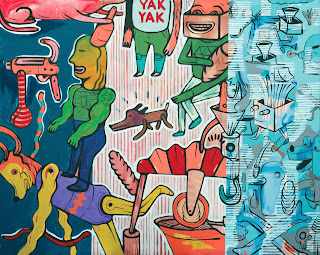Yang Lain-Lain @ Suma Orientalis
The gallery’s publicity statement for “Yang Lain-Lain” touts Donald Abraham as a Sabah-born street artist, pointing out the artist’s lack of formal training, and “YAK” graffiti tag as his signature. Most exhibits are acrylic paintings on canvas or board, some with collaged snippets, effectively marking this a typical gallery showcase. In an interview with the local newspapers, the artist admits, that “(i)t’s a daunting challenge to go down the gallery path. But it’s a natural career progression”. Visitors are greeted by ‘The Green Monster’, its arrangement of cynical symbols indicative of the literal and boring characteristics, that typify Malaysian paintings making political commentary. Fortunately, this is the only poor example, in this exhibition of fantastic works.
 |
| Drifting (2016) |
For one with a signature style – his murals within Publika’s indoor walkways are immediately recognizable – there is an amazing diversity in Donald’s drawings of people & things. Numerous characters populate his canvases, and just looking at the depicted heads & faces is sufficient to sustain one’s visual interest for a considerable time. Some are depicted as looking at the viewer, some are in profile, some are from the top, some are turned away. No box heads, animal heads, or rocket heads, are the same. Pursed lips or teeth-baring mouths, are attached to hooked noses or nostrils pointing upwards, while a variety of eyes bear the expressions of shock, calm, detached, alert. A significant feature is the size of drawn figures, which make the works as easy to see as a comic strip, and the symbols utilized are seldom too vague or too specific.
 |
| 3 Scenario (2014) |
The comic strip is used as an illustrative narrative device in ‘Drama’, an approach also seen in one exhibit currently on show at Menara Maybank. “Yang Lain-Lain” includes Donald’s output from 2012 to 2018, which provides the viewer an insight into the artist’s aesthetic experiments. From ‘3 Scenario’ (2014) – a depiction of “childhood, adolescence and adulthood” – to works completed in 2015, its characters adopt a fleshy pink-orange hue and leave more empty space between them, as compared to other exhibits. Perhaps, the artist’s young child was born during this period? White parallel lines reappear in ‘Chop Suey’ (2018), a dense picture where every figurative motif and expressive motive is cramped onto a single canvas. Brick walls & sculpted waves are apparent also in newer works, and the white fill-ins in ‘Street Workers’ present a fresh scheme for colouring figures.
 |
| Street Workers (2018) |
Such observations are made possible, when contrasted against the three large and bright works completed in 2012. Donald’s approach is described in a recent interview, where he “…imagined what he wanted to paint before putting the base colours in first. He completed the painting by accentuating the characters with black outlines.” This simple statement betrays the multiple layers of design that cover each work, which injects Donald’s work its characteristic style and aesthetic appeal. ‘Untitled (Pompodon)’ is a good example of this approach, where faded neon colours draw connections or patterns in the background, while in the foreground of outlandish figures are illustrated in dark outlines. The immediacy of images recalls a mural quality and its association with street art, yet the inherent contrasts in tone attract the viewer to linger then roam visually in front of the paintings.
 |
| Untitled (Pompodon) (2012) |
‘Playground’ (2017) presents an evolving and maturing approach, where visual depth is crafted via diagonal planes, and the relatively fewer figures are balanced by a more focused and purposeful depiction. Who is asleep, and who is awake? What do the dark blue and dark green characters (including a Ninja Turtle and a bearded sage) represent? Why is only half the yellow face shown, and where is the handheld revolver pointing at? Motifs with corresponding scale & colour present surface layers, that clusters characters & things into an interconnected whole, which the viewer can then freely interpret. Despite its landscape format and numerous subject, one does not get overwhelmed by what is presented, as there is order in the chaos.
 |
| Playground (2017) |
My favourite works in this exhibition, are unquestionably the square paintings from 2016-2017. In ‘Drifting’, luminous heads – including a Trump-like profile – surround a bald figure with a paper ship on his head. Alert eyes dart in different directions, yet a sense of melancholy pervades as the spectral character drifts among the crowd. A similar sense of finding one’s way appears in ‘100s of Line’, where a pink character surfs through a larger crowd on a #skatedog, the apparent bravado also projecting an outsider detached from one’s surroundings. This approach reaches its zenith in ‘Running Boy’, where the crowd of figures are densely packed and seem to join and form out of each other. Donald’s design is organic yet forceful, which style approaches a continuous line of stream-of-consciousness drawing. Stress-inducing expectations are a feature of modern urban life, and there is no running away.
 |
| Running Boy (2017) |
Donald’s images do not nullify, but complement each other with its symbolism and formal properties, a mean feat which many Malaysian artists strive for but do not attain. In a response to a journalist’s question about his personal favourite work, the artist states, “I don’t have a favourite. I love them all. My art contorts reality as I express my subjects spontaneously. This world is vast. And my repertoire is to sing along, capturing its beauty, funny moments and hard facts onto my canvas. But I’m no soothsayer. I just love what I’m doing.” Vivid & colourful, intricately layered, full of character, and well-drawn motifs – there is plenty to enjoy and like in Donald Abraham’s art. By promoting it as street art, the gallery has sold these works short. In short, this is good art, whenever it is shown, and wherever the artist hails from.
 |
| Detail snapshots |
Comments
Post a Comment